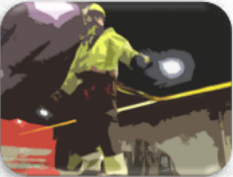Working at Height?
The Work at Height Regulations define work at height as any place, if measures are not taken, a person could fall a distance liable to cause injury. This includes standing on the ground on the edge of a shaft for example.
In our industry we can think of obvious examples of working at height, such as use of a MEWP, rope access in a tree, rigging a cable crane or spar tree, or gantries and platforms around a biomass plant. But do you consider working on the trailer of a lorry or on top of forest machinery during maintenance to qualify as working from height too?
The Work at Height Regulations are relatively straight forward. Using the example of sweeping off the backs of trailers let’s look at how the regulations can be simplified and applied:
- Don’t work at height – If you aren’t at height you can’t Can you sweep the trailer down while standing on the ground? This is achievable for a Skeletal trailer.
- Don’t fall – Put simply, if you don’t fall then you can’t be In our example a gantry around the trailer would prevent falling from the edge, or more practicably in the forest the fall restraint system developed in the industry and promoted in the FISA Bulletin prevent the user from reaching the edge of the trailer.
- Don’t land – It is the landing that causes the injuries, so can you prevent the landing? Crash mats around a trailer won’t stop you falling but will prevent you from landing on the hard ground. Fall arrest systems from overhead gantries in timber yards will snatch and arrest your fall.
In all cases, controls that protect all users and don’t require user action should be favoured where reasonably practicable, e.g. a handrail on a platform.
FISA Safety Bulletin FOREST HAULAGE WORKING AT HEIGHT May 2020
Remember
• Falls from Height is among the top 5 types of Fatal and Serious Injuries in the UK each year.
• Controls have to be proportionate to the likely injury.
• Collective passive controls take priority over individual active controls.




